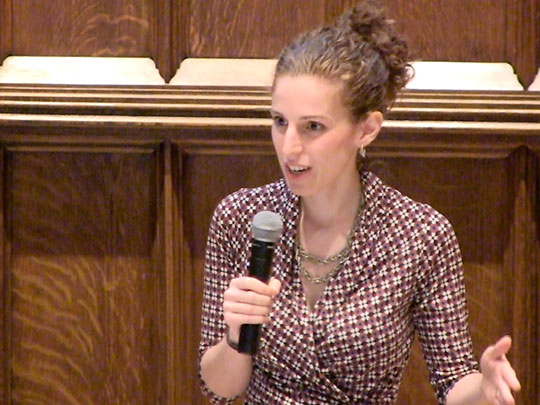Teaching as a Team Sport: Elizabeth Green and others discuss the sharing of best practices among teachers
If a kid multiplies 49 by 5 and comes up with a wrong answer of 245, can you explain why?
Knowing the reason, which has to do with a common mistake in carrying numbers, may not be essential for doing math – but it is for teaching it, according to education journalist Elizabeth Green.
Speaking in TC’s Milbank Chapel this past fall, Green, author of Building a Better Teacher: How Teaching Works (and How to Teach it to Everyone), anchored a panel focused on the importance of teachers sharing precisely these kinds of insights. Her fellow speakers included TC President Susan Fuhrman; Andy Snyder, a social studies teacher at New York City’s Harvest Collegiate High School who appears extensively in Green’s book; and panel moderator Liz Willen, director of TC’s Hechinger Institute on Education and the Media.
In her book, which grew out of an assignment for The New York Times and was written while she was a Spencer fellow at Columbia Journalism School, Green argues that the ability to not only understand content well enough to teach it but to anticipate and account for ways in which students might misunderstand it is particularly important. Indeed, that talent has become so prized by some charter schools, she said, that “They’ve given up trying to find great teachers who are naturally born, instead they’ve invested in training teachers in these specialized skills.”
Green and her fellow panelists agreed that beyond possessing love and respect for children and a passion for her craft, good teachers often are a product of opportunities to closely with colleagues and build off their ideas. Green described how Magdalene Lampert, a teacher disillusioned with the American education system, discovered salvation while on sabbatical in Rome. At the language school where Lampert was studying Italian, the teachers not only all studied together, they were given time to create a common lesson bank to help each other help students struggling with common grammatical misunderstandings.
Snyder, whose school is part of a consortium of schools that advocates performance-based assessment over standardized testing, said he teaches a course, “Looking for an Argument,” that another teacher, Avram Barlowe of the Urban Academy, created as a result of just such collaboration “Because I was building on Avram’s course my students got something better than if I had just invented that by myself,” he said. “We need to set up those conditions where the best practices can spread and are always being further refined. It doesn’t have to be robotic.” Snyder said that students should ideally work in the same way. His school works with the College, Career, and Civic Life (C3) Framework for Social Studies State Standards, which were designed to develop better future citizens through social studies.
“What do good citizens do?” Snyder asked. “They ask questions, they do research. They figure out how to take action together. By the end of their high school experience, these students will be ready to be really good citizens.”
Green thinks the United States could benefit from adopting a model she saw during a recent visit to Japan: a course of study that gets revised every ten years with the input of some of the best teachers in the country, as decided by their peers. “The teachers all believed that they were maestros,” she said. “They thought they were teaching differently from any other teacher in Japan. I thought of the art form of Haiku — the most controlled possible art form that you could imagine, but within it, a ton of creativity.” – Jonathan Sapers
Published Tuesday, Feb. 3, 2015
